Chinese Name: 黑龙潭公园 Pronunciation: Hēi Lóng Tán Gōng Yuán
Building Time: 1454
Recommended Time for Visit: 2-3 Hours
Address: No.1 Lan’an Road, Panlong District, Kunming, Yunnan Province
Occupied Area: 91.4 hectares (About 914,000 square meters)
Popular Activities: Go hiking, go for a picnic and enjoy Huadeng (a traditional Yunnan opera)
Best Visiting Season: Spring and winter (January to March, October to December)
1. Children under 1.2 meters (including 1.2 meters) or six years old (including 6 years old), seniors over 70 years old (including 70 years old), active servicemen, ex-servicemen, and disabled persons are free of charge with valid certificates.
2. Full-time student with a college degree or below enjoys the half price of 3.5 yuan with valid certificates.
| Opening Hours | 8:00-17:00 |
| Ticket Office Opening Hours | 8:00-16:30 |
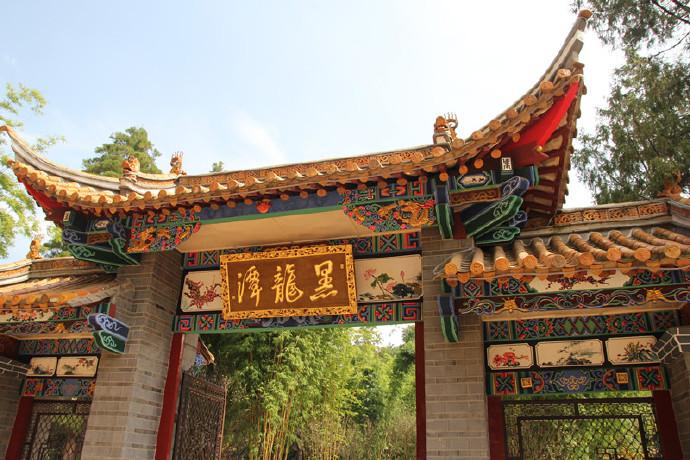
The Heilongtan Park (literally meaning Black Dragon Pool Park) is located at the foot of Wulao Peak of Longquan Mountain (also known as Taiji Mountain, or Wulao Mountain) in the northern suburb of Kunming. It covers an area of 91.4 hectares and is about 17 kilometers away from the city center. Endowed with ancient trees, limpid springs, lush forests, and green lakes, the park has “Tangmei” (plum blossom trees planted in the Tang Dynasty), “Songbai” (cypress trees cultivated in the Song Dynasty), “Yuanshan” (cedar planted in the Yuan Dynasty), and “Mingcha” (camellia planted in the Ming Dynasty), which are called “Four Beauties” of the Heilongtan Park.
The Heilongtan Park mainly includes the following scenic spots: the Longquanguan Taoist Temple, the Black Dragon Palace (Heilonggong), the Black Dragon Pool, the Plum Blossom Garden, the Waterscape Garden, the Osmanthus Garden, the Boutique Garden, the Rhododendron Valley, the Red Maple Forest, and the Martyrs’ Cemetery.
The Heilongtan Park is a famous Taoist resort, which evolved from the Heishui Ancestral Hall in the Han Dynasty. The Heishui Ancestral Hall mainly includes the Longquanguan Taoist Temple, built in the Tang and Song Dynasties, and the Black Dragon Palace built in the Ming Dynasty.

The Black Dragon Palace and the Longquanguan Taoist Temple were announced by the Kunming Municipal People’s Committee as a municipal key cultural relics protection unit in 1961. In November 1993, the Yunnan Provincial People's Government announced them as provincial key cultural relic protection units.
The Heilongtan Park has a rarely seen large plum blossom garden, which is a scenic spot for visitors to enjoy plum blossoms during the winter days in Kunming. The "Tangmei (a plum blossom tree planted in the Tang Dynasty) ", as legend has it, was transplanted from the Nanzhao (738-937), a state in southwestern China in ancient times, and is considered to be one of the two most precious ancient plum blossom trees in Yunnan Province.
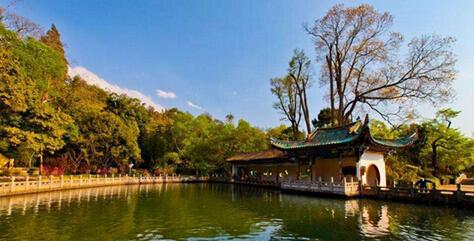
The Black Dragon Pool, built in the fourth year of Jingtai (1454) of the Ming Dynasty, is enclosed by a stone fence. Springs from underground add more elegance to the gorgeous scenery, but there is such a strange phenomenon: the Black Dragon Pool is divided into two pools by a stone bridge in the middle—the water of one side is clear while the other side is turbid, but the clear and turbid waters do not blend.
The deep pool is called Qingshuitan (Clear Water Pool) because the clear spring water flows from the bottom of the pond. The circular Qingshuitan covers an area of 600 square meters. The water is 15 meters deep.
The ancient building complex next to the Black Dragon Pool is the "Black Dragon Palace". It was built in 1394, the 27th year of the Hongwu period of the Ming Dynasty and was rebuilt in 1454.
The Black Dragon Palace has four courtyards, surrounded by dense green trees. The main hall enshrines the statue of the dragon king, and the auxiliary hall enshrines statues of the water gods. The wall of the main hall is embedded with an inscription stele which was inscribed by Fan Chengxun, the governor of Yunnan and Guizhou during the Kangxi period of the Qing Dynasty.
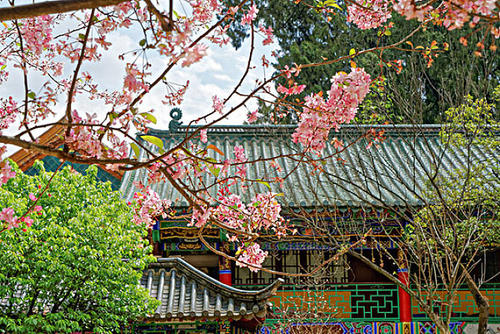
Entering the gate with a plaque, inscribed "紫极玄都", hung above, visitors can see thirteen courtyards, including the Leishen Hall, the Beiji Hall, the Jade Emperor Hall, the Sanqing Hall, and the Changchun Zhenren and Tongmiao Zhenren Temples.
The entire building complex was built layer by layer along the mountain edge from south to north. The first layer is the front gate, the second layer is the Leishen Hall, the third layer is the Beiji Hall (now the Patriarch Hall, the Doumu Pavilion is arranged on one side of the hall), the fourth layer is the Jade Emperor Hall, the fifth layer is the Sanqing Hall, and each hall was arranged together with side halls and wing rooms. The Tianshi Hall, the Sanfeng Hall, the Changchun Zhenren Temple, and the Tongmiao Zhenren Temple are all arranged from the north to the south.
On both sides of the passage in front of the Leishen Hall, there are two peacock firs, a precious plant, planted in the Yuan Dynasty. The one on the east is particularly luxuriant and is about 26 meters high, while the other on the west withered after being struck by lightning in 1979, and now is only about 10 meters high. On both sides of the passage are two strange twisted cypress trees planted in the Yuan Dynasty, one twisted to the left while the other twisted to the right, commonly known as "left-twisted cypress and right-twisted cypress". The “right-twisted cypress” was crushed by snow in 1984, leaving only a 6-meter high withered tree trunk.
Planted in the front yard of the Beiji Hall are a plum blossom tree of the Tang Dynasty and a camellia of the Ming Dynasty.
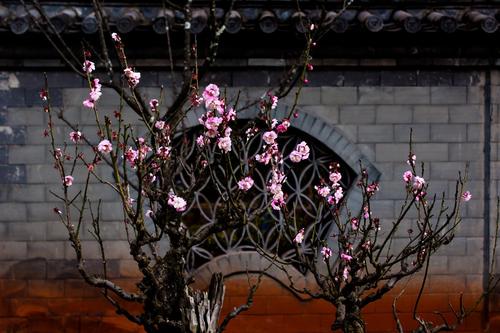
During the Kaiyuan period of the Tang Dynasty, a monk named Dao’an traveled to Kunming from the Luoqi Temple in Dali and planted two plum blossom trees. During the Jiaqing period of the Qing Dynasty, the two ancient plum blossom trees rotted and were nearly dying, but soft branches were still growing. In 1923, the two trees died naturally, leaving a quarter of the stem. The branches and trunk of one dead tree look like a sleeping dragon. The existing plum blossom trees are growing from the old ones. After thousands of years, this plum blossom tree is still praised by people.
The camellia was planted in the Ming Dynasty with a history of more than four hundred years. The tree is 8 meters tall. Every winter, the flowers are in full bloom and look very gorgeous.
“Tangmei (plum blossom trees planted in the Tang Dynasty)”, “Songbai (cypress trees cultivated in the Song Dynasty)”, and “Mingcha (camellia planted in the Ming Dynasty)” are collectively called the "Three Precious Plants" of the Heilongtan Park. Guo Moruo, a well-known Chinese poet, once wrote a poem after visiting the Heilongtan Park in 1961, praising the park's "Three Precious Plants".

The Longquanguan Taoist Temple houses a large number of precious steles from the previous dynasties, including the Tangmei stele (built for the two precious plum blossom trees planted in the Tang Dynasty), the embossed stele, the Songbai stele (built for the precious cypress trees planted in the Song Dynasty), the portrait stele of Zhang Sanfeng (the founder of Wudang Taoist School), the stele of the poet inscription of Ruan Yuan (a high-ranking official of the Qing Dynasty), and so on.
The sidewalls of the two front courtyards of the Black Dragon Palace are also inlaid with the inscription of "reconstruction of the Black Dragon Palace stele" in the first year (1821) of the Daoguang period of the Qing Dynasty, and the stele inscribed the inscription of the official Fan Chengxun's visiting to the Black Dragon Pool during the Kangxi period of the Qing Dynasty.
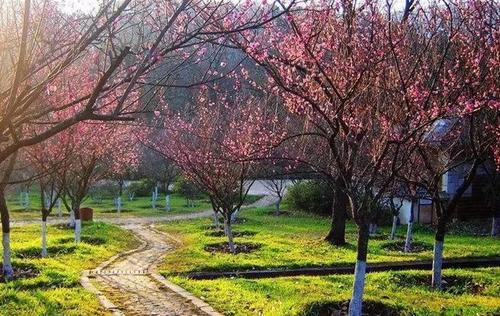
The Plum Blossom Garden is located in the north of the Longquanguan Taoist Temple, with the Sanqing Temple in the east, the Longquan Road in the west, the Osmanthus Garden in the south, and the Rhododendron Valley in the north. The construction of the garden lasted from September 1991 to the end of 1993 with a total investment of 4.5 million yuan.
The Plum Blossom Garden covers an area of 28.5 hectares, where about 1,700 plum blossom trees of 28 varieties were planted. It was officially opened for visitors to go sightseeing on New Year's Day in 1994. The garden is also named “Longquantanmei” (Exploring Plum Blossoms in Longquan) and is considered to be one of the new sixteen scenic spots in Kunming. The Plum Blossom Garden includes four scenic spots, namely, the Plum Blossom Bonsai Garden, the Plum Blossom Variety Garden, the Fruit Plum Blossom Garden, and the Plum Blossom Viewing Area.
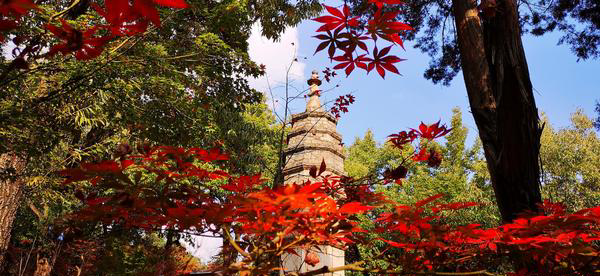
In 1997, in the memory of the day of the "returning of Hong Kong to the motherland", a red maple tree forest was fostered in the Heilongtan Park to welcome the returning of Hong Kong. The forest covers an area of 2 hectares, where more than 2,000 red maple trees were planted, and stone monuments were established. In late autumn, the red leaves of the maple trees sway with the wind, presenting a gorgeous picture that attracts visitors to enjoy.
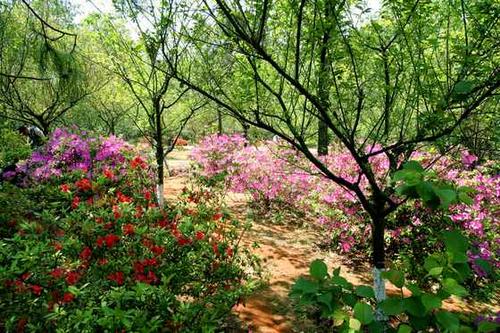
The Rhododendron Valley is close to the Plum Blossom Garden. It covers an area of 8 hectares and more than 100,000 rhododendrons were planted here. Around the Qingming Festival (around April 5th), the mountains and valleys are full of rhododendrons, presenting a sea of flowers. Every year from April to May, tens of thousands of visitors will flock to the valley to enjoy the beautiful scenery.
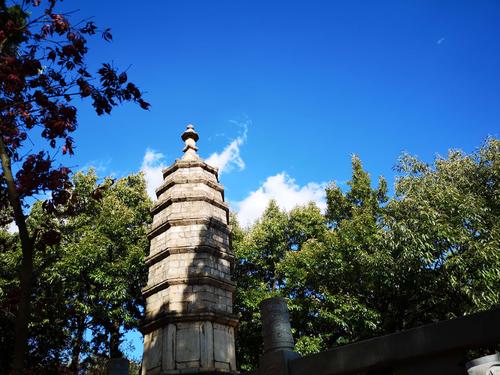
The Dingfeng Tower is 13 meters high and is a seven-story octagonal tower. The tower is also known as the Wenbi Tower. It was built in the Ming Dynasty and was rebuilt in the second year (1852) of the Xianfeng period in the Qing Dynasty. The seven-level tower is built by dolomite, with fine carvings and dignified shape.
The tower is engraved with the names of Taoist gods, with the recording of "reconstruction of the Dingfeng Temple" and Taoist "Jade Emperor Scriptures". According to the rebuilding inscription, to make the Taoist temple more spectacular, the Dingfeng Tower was also rebuilt in 1993.
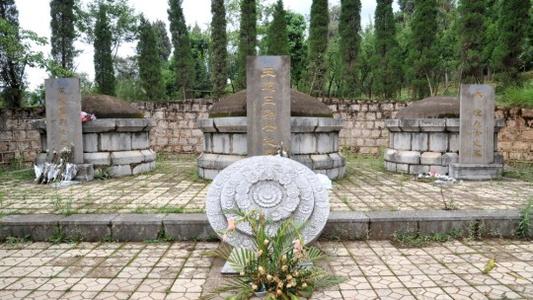
On the slope of Longquan Mountain, among the pines and cypresses, are the tombs of five martyrs --Wang Desan, Wu Cheng, Ma Dengyun, Wang Fusheng, and Zhang Fang who made contributions to the liberation of Yunnan Province in the 1930s.
Renovated in 1984, this cemetery is a key cultural relic protection unit in Yunnan Province. The cemetery faces south and has a rest pavilion. With stone fences' protection, the cemetery is surrounded by pines and cypresses. A peaceful place is created for martyrs to rest, and for the later generations to mourn.
Heilongtan Park is also known as “Black Dragon Pool Park”. The name of the “Black Dragon Pool” was originally from a legend. A long time ago, ten dragons often did evil things to the local people. Lü Dongbin, one of the eight immortals in Chinese legend, conquered nine of them and suppressed them under the Tuodong Tower in the urban area. Only a small black dragon, which promised to do good things to benefit the people, was allowed by Lü Dongbin to live in the pool. Hence people called the pool “Black Dragon Pool”.
Enter from the West Gate of the Park→Plum Blossom Garden→Heilongtan Pool→Longquanguan Taoist Temple→Dingfeng Tower→Black Dragon Hall→Red Maple Forest→Rhododendron Valley→Martyrs’ Cemetery→Exit from the Southwest Gate.
Take bus 9, 79, 128, and get off at the Heilongtan Station.
Chinese: 请带我去黑龙潭公园。English: Please take me to the Heilongtan Park.
Chinese: 请带我去黑龙潭公园的西门。English: Please take me to the West Gate of the Heilongtan Park.
Chinese: 请带我去黑龙潭公园的西南1门。English: Please take me to the Southwest Gate 1 of the Heilongtan Park.
Chinese: 请带我去黑龙潭公园的西南2门。English: Please take me to the Southwest Gate 2 of the Heilongtan Park.
Chinese: 请带我去黑龙潭公园的西南3门。English: Please take me to the Southwest Gate 3 of the Heilongtan Park.
If you go to the Heilongtan Park from the center of Kunming (Dongfeng Square), it takes about 52 minutes (about 50 yuan).
If you go to the Heilongtan Park from Kunming Changshui International Airport, it takes about 54 minutes (about 90 yuan).
If you go to the Heilongtan Park from Kunming South Railway Station, it takes about 85 minutes (about 125 yuan).
If you go to the Heilongtan Park from Kunming Railway Station, it takes about 60 minutes (about 71 yuan).
